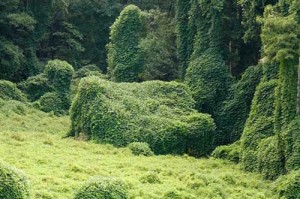 Need another reason to hate kudzu, the green leafy vine that is pervasive throughout the Southern United States? How about this: a recent study published in the journal Proceedings of the National Academy of Sciences shows that kudzu is a contributor to surface ozone pollution. The invasive plant, which was introduced in the late 1800s for erosion control, emits high levels of isoprene and nitric oxide which combine with the nitrogen in the air to form ozone. The study, which was conducted by researchers at the University of Virginia, showed the presence of kudzu can double the level of nitrogen oxide emissions from soil. Rampant expansion of kudzu could even increase the number of high ozone alert days in a given year.
Need another reason to hate kudzu, the green leafy vine that is pervasive throughout the Southern United States? How about this: a recent study published in the journal Proceedings of the National Academy of Sciences shows that kudzu is a contributor to surface ozone pollution. The invasive plant, which was introduced in the late 1800s for erosion control, emits high levels of isoprene and nitric oxide which combine with the nitrogen in the air to form ozone. The study, which was conducted by researchers at the University of Virginia, showed the presence of kudzu can double the level of nitrogen oxide emissions from soil. Rampant expansion of kudzu could even increase the number of high ozone alert days in a given year.
Kudzu now occupies more than 7.4 million acres in the U.S., expanding at 120,000 acres annually. Kudzu vines have been known to grow up to a foot a day.
But we don’t want you to think kudzu is all bad. Some Southern families have used kudzu as a food source for decades, cooking up fried kudzu leaves, kudzu quiche, steamed kudzu…and some entrepreneurs have been trying to turn kudzu into a biofuel cash crop as well.
Go here for the full kudzu study.







